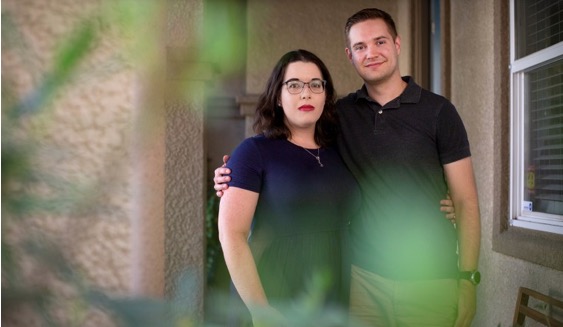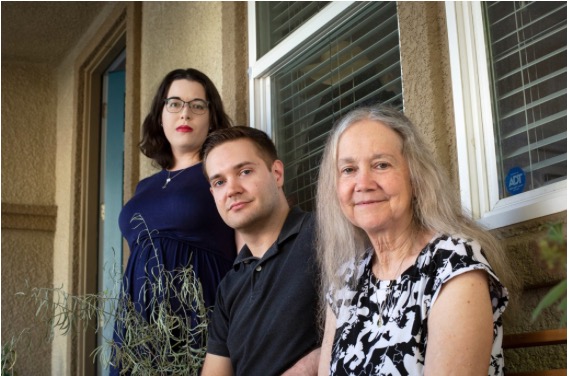CommentsWELLNESS - Former grad school classmates Kelsey McQuaid-Craig and Chelsea Oruche have recently bonded over a similar struggle — trying to place loved ones in assisted living.
McQuaid-Craig and her husband, Brandon, are looking to place his mother, Mary, 67, who has dementia and is deteriorating quickly, in a memory care program in Sacramento County. They are currently expecting their first child, and caring for Mary full time while juggling their careers has become overwhelming.
In San Pedro, Oruche is experiencing a similar stress. Caring for her 70-year-old mother, Peggy, who has multiple health issues, while raising a toddler, attending law school and working is leading to burnout.
Assisted living and memory care centers aren’t cheap — about $5,000 to $7,000 a month — a high cost even for families with somewhat comfortable incomes. So the two friends looked into Medi-Cal, which through a special project, covers assisted living costs for eligible low-income seniors and people with disabilities in 15 counties, including Sacramento and Los Angeles.
Demand for the program is high and the slots are limited. Scoring a spot in Medi-Cal’s assisted living program is a years-long odyssey for some, leaving family members who serve as caregivers stretched thin as they scramble to find workarounds for their loved one’s care and living situation.
The state has been expanding the program, which is good news for families interested in this service, but for some in line now, it could still be more than a year before they are placed in a facility.
Because spots are limited, generally those interested must first get on a waitlist. Those waitlists can be lengthy — in some cases, people being placed now have been waiting since 2019.
McQuaid-Craig said that in January she was told by care coordination agencies, which contract with the state to assess individuals and help place them in a facility, that the wait could be as long as two years in the Sacramento area. The few agencies that shared estimated wait times with Oruche in the spring told her that Peggy’s wait could be anywhere from one to three years in Los Angeles County.
According to the state’s most recent data, there are 6,301 people enrolled in Medi-Cal’s assisted living program and 4,754 people are waiting to get in.
In the meantime, families try their best to care for their loved ones with very little respite. Peggy, for example, has chronic pain stemming from a fall decades ago. Some days are better than others, but she deals with depression, anxiety and neurological issues, and it’s become clear that she may need more care than Oruche can provide.
“We’re operating under water,” Oruche said. “It’s not sustainable. It is a full-time job to care for a parent. Unless you’ve done it, you can’t wrap your head around it.”
She believes placing her mom in assisted living will help rekindle family relationships. “It will allow us to be her kids again,” she said.
Supply and demand
A waitlist to get into this program isn’t new, but demand continues to outgrow supply — signaling that California is in need of more housing and care options for low-income seniors who can no longer live on their own. Aging and health advocates say this is concerning, especially as one quarter of Californians are expected to be older than 60 by 2030.
In response to the growing demand, California sought approval from the federal government to secure 7,000 additional slots for its Medi-Cal assisted living program. It got the green light in January. (Because Medi-Cal is jointly funded by the state and the federal government, the state needs federal permission to expand programs.)
Officials with the California Department of Health Care Services, which oversees the program, said they started rolling out these new spots in May and plan to clear the waitlist or at least reduce it substantively by Feb. 28, 2024.
“The Department recognizes that achieving this goal is dependent on several external factors, including [coordinating agencies’] capacity, bed availability, and continued growth of the demand,” Katharine Weir, a spokesperson with the Department of Health Care Services, said in an email.
Weir said the department is also working toward integrating the assisted living services with another one of its long-term care programs, which should streamline services and allow more people to access assisted living.
Advocates say the need is probably much higher than enrollment and waitlist numbers reflect. Many Californians do not know that assisted living, including some memory care programs, is an option for eligible low-income people on Medi-Cal. (While services are paid for, people do pay a portion of the cost for their room and board through their supplemental security income.)
Maura Gibney, director of organizational development at California Advocates for Nursing Home Reform, described Medi-Cal’s assisted living program as opaque. Many people don’t know that this benefit is available because there is generally not a lot of public outreach about the program, Gibney said.
“But if there was, the waitlists wouldn’t be two years long, they’d be five years long,” she said.
Navigating the system
Seniors and people with disabilities who need round-the-clock medical care often require a nursing home setting, which is a mandated benefit under Medi-Cal, and people who qualify are often placed immediately in those facilities. Assisted living is considered an alternative for people who don’t need to be in a clinical environment, but may need assistance completing daily tasks.
In California, 55% of older residents and people with disabilities need help from another person for routine care, such as completing chores, shopping or getting to appointments, according to a recent analysis from the UCLA Center for Health Policy Research. About 21% need help with personal care, like eating, bathing and getting dressed. Of those who need assistance, 40% reported needing more or not receiving any at all.
People on Medi-Cal generally have two entryways into assisted living. They can be placed immediately if they are being discharged from a hospital or being transferred from a nursing home. These individuals are prioritized for the assisted living program because hospital care and nursing home living is more expensive, so this move saves the state money. People who are transitioning into assisted living from their home must first get on a waitlist. Once it’s their turn, they can submit an application to enroll in the program. Historically, about 60% of people on the waitlist end up enrolling in the program, according to the Department of Health Care Services.
This means that while folks wait, caregiver duties usually fall on a daughter or son or another relative who bears the brunt of the cost and work. About 91% of Californians who care for a family member or friend do so without getting paid, according to state data.

Kelsey McQuaid-Craig and her husband Brandon J. Craig at their home in Sacramento on Aug. 8, 2022. Photo by Miguel Gutierrez Jr., CalMatters
There’s the cost of temporary care when McQuaid-Craig and her husband have to travel and the house adjustments to make it safer and easier for Mary to get around. Then there is the mental and emotional toll: the hours-long struggle of trying to convince Mary it’s time for a bath; the patience to calm her when she gets agitated.
After McQuaid-Craig learned she was pregnant, she looked for ways to speed up the process of getting Mary into a memory care program. Care coordination agencies told her that unless Mary fell or became ill and landed in a hospital or nursing home, the only other way to place her sooner was to get the county’s Adult Protective Services agency involved.
Through this process, the county agency sends a case worker to people’s homes to assess their living situation. If this agency decides that a person is experiencing abuse or neglect, it can fast-track a person’s move into assisted living. Self-neglect, when a person is no longer able to care for themselves — can’t feed, clothe or take care of their own health — can also qualify a person for an expedited process.
“We had to file a self-neglect case because there is no abuse, but we also are running up on not being able to take care of her for much longer. Unfortunately, that was the only way to move her up (on the waitlist),” McQuaid-Craig said.
McQuaid-Craig and Oruche met during their graduate studies at the University of Southern California’s public administration program in Sacramento. McQuaid works in health policy for the California chapter of the American Colleges of Emergency Physicians, Oruche for a venture philanthropy. Both said the cumbersome process of trying to place their parents in memory care and assisted living raises questions about how accessible the program truly is.
“I have to imagine that if two highly educated, white women are struggling to get answers and find placement for their low-income loved ones then there is a lot more going on here. Especially for immigrants or non-native English speakers, and those who do not have connections,” McQuaid-Craig said.
During their research, they grew frustrated by the lack of transparency from some of the care coordination agencies they contacted. There are 31 agencies in the state, according to a recently updated list from the California Department of Health Care Services.
Each agency has its own waitlist, and a person can only sign up with one. Meaning choosing one over the other could be the difference in how long people wait. She wanted to know how long each waitlist was to choose the shortest one. A list provided last week by the Department of Health Care Services shows agencies’ waits vary greatly, with lists as short as one individual to as long as 929 people.
But for Oruche “Half of the agencies on the list (serving Los Angeles County) did not respond. And of the half that did, only four or five gave me a number,” she said. Some of the agencies told her that her request was unusual, she added.
Neil Rotter, CEO of Libertana, a care coordination agency serving Fresno and Southern California, said agencies don’t always tell people where they stand in line because they don’t want to deter people from seeking services; plus, that number could change quickly from one month to another. He said his agency is upfront with families when it is experiencing a longer wait than other agencies.
Rotter said part of the challenge is the state’s move from a single statewide waitlist to an agency-specific waitlist. That’s when the state department started issuing an equal number of slots to each agency every month, which has prompted questions about how fair that is. For example, people who sign up with newer agencies with shorter waitlists may be placed before someone who has been waiting longer at an older agency.
Lauren Firenze, program director at Senior Care Solutions, a care coordination agency that serves Sacramento and San Joaquin counties, echoed this concern. Firenze advises families to contact more than one agency and figure out which is the most helpful and responsive. Also, “don’t wait until you’re in crisis to get on the waitlist. Some people wait too long to access services,” she said.
As of last week, McQuaid was working on an expedited assisted living application for Mary, and Oruche ultimately chose a care agency that gave her an estimated year wait time. Oruche said she has also talked to Peggy’s doctor about the nursing home option, and although that is not Peggy’s preference, going to a nursing home first would allow her to more quickly transfer into assisted living.
But that option “seems really inefficient and really disruptive to her mental health,” Oruche said.
For now, Mary and Peggy continue to wait.
(Ana B. Ibarra covers health policy and the COVID-19 pandemic. She joined CalMatters in 2020 after four years at Kaiser Health News. She started her reporting career at McClatchy’s Merced Sun-Star. Her work has also appeared in The Washington Post, the Los Angeles Times, USA Today and many other state and national news outlets.This article was featured in CalMatters.)
























